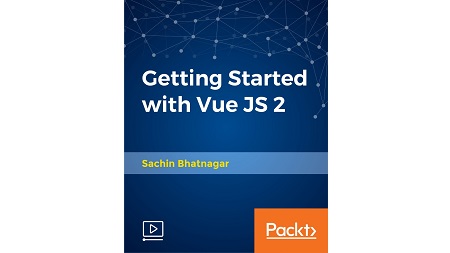
English | MP4 | AVC 1280×720 | AAC 44KHz 2ch | 11h 37m | 2.60 GB
Master VueJS 2 for building super cool user interfaces and high performance web apps!
Once upon a time, JavaScript could only be used for simple form validators. Well, time has changed and if you’re a web designer or developer, chances are that your next big project requires a cutting edge web application framework that offers state of the art features such as a Virtual DOM, Reactivity, Superhero performance, all with a feather light footprint. That is where Vue JS comes in. Vue JS is an amazing JavaScript framework for building high performance user interfaces but has enough ammo to power your next killer web application. In this beginner’s course on VueJS, we will go from the absolute basics of a framework, including concepts such as DOM and setting up a development environment, to understanding core Vue features, essential workflows and best practices. You will work through 20+ hands-on exercises to solidify your command on essential Vue concepts. Vue offers the best of Angular and React and features a component based architecture that lets you break down your app or even an interface into manageable and scalable functional units. VueJS apps offer incredible performance that is neck to neck and even better than some of the leading web app frameworks in use today. Vue features a Virtual DOM that is lighter than the rest and delivers impeccable performance. If you’re a web designer, developer or even a project manager with a goal to master or pick a web application framework for your project, but are too afraid to begin, then this is your chance to finally realize your dream. Vue is surprisingly simple to learn, which makes it a winner and enables existing production grade projects and teams to incrementally bring it into their ecosystem.
Vue is surprisingly simple to learn, which makes it a winner and enables existing production grade projects and teams to incrementally bring it into their ecosystem.
What You Will Learn
- Build Webapps using JavaScript
- Master concepts such as directives, templates, methods, watchers and more.
- Master Vue with over 20 hands-on projects
- Build and Integrate Vue apps into existing sites
- Build complete data driven single page web apps
- Fetch data from third party APIs
- Understand build systems and webpack for use with Vue
- Use Vue’s Single File Component architecture for building large apps
- Incorporate routing for multi-page apps using Vue Router
- Use Google’s Firebase Realtime Database in a Vue app
- Secure your Vue apps with Firebase Authentication
- Deploy Vue apps on the web
Table of Contents
Prologue
1 A Warm Welcome
2 What is VueJS
3 Anatomy of an app
4 Setting up for development
5 Hello Vue _ First Steps
6 Hello Vue _ Form Input
7 olleH euV _ v-model and filter
8 The Virtual DOM
9 Reactive Data and The State
Discovering Templates
10 Introduction to Templates
11 Using Strings
12 Using String Literals
13 Using Inline Templates
14 Using X-Templates
15 Using Render Functions
16 Using JSX
17 Summary
Rendering Lists and More
18 Summary
19 Colored Boxes
20 A Simple Shopping Cart
21 A List Widget
Data flow and components
22 One way data flow
23 Two way data binding
24 A Sales Request Form _ Chapter One
25 A Sales Request Form _ Chapter Two
26 A Sales Request Form _ Chapter Three
27 A Sales Request Form _ Chapter Four
28 Super Button
29 Rating Meter Reloaded
Lifecycle Methods and lots more..
30 Summary
31 A Notification utility
32 An Image Carousel
33 An Image Carousel _ Conclusion
34 A Weather App _ Introduction First Steps
35 A Weather App _ Continued
36 A Weather App _ Conclusion
37 Currency Converter
38 Currency Converter _ Conclusion
39 Understanding Lifecycle Methods
Introduction to Single File Components
40 Summary
41 Introduction to Single File Components
42 Introduction to Module Bundlers Task Runners
43 Using Webpack – The Basics
44 Using Webpack – Setup _ Part 1
45 Using Webpack – Setup _ Part 2
46 Using Webpack – Palindrome App _ Code
47 Getting back to Vue.js and Single File Components
48 The VUE-CLI and Getting Started with Eatsapp
49 Understanding the template structure
50 Downloading assets for this project
51 The core app component
52 Getting data from an API
53 The Data Object
54 The ListItem Shell
55 The ListItemPhoto component
56 The ListItemText component
57 The RatingMeter component
58 Listening to events
59 The InfoCard component
60 Building for production
61 Deploying the app
Building an Address Book using Firebase
62 Summary
63 Introduction to the project
64 Setting up a Vue App
65 Downloading Assets
66 Understanding routing in a single page app
67 Implementing routing using the vue-router
68 The app shell
69 The Home component
70 The ContactListItem component
71 The AddContact component
72 The UserInput component – Input fields
73 The UserInput component – Props events
74 The UserInput component – Social IDs
75 The UserInput component – Conditional styling
76 The AddContact component – v-model
77 Basic validation
78 The AddContact component – Clearing out the form
79 Setting up Firebase Realtime Database
80 Saving data to Firebase
81 Offline notification
82 Preloader and more
83 The ContactDetail component – Route parameters
84 The ContactDetail component – Template design
85 The ContactDetail component – Displaying data
86 The ContactDetail component – Watchers
87 The UserResponse component – Using slots
88 Deleting a contact
89 Deploying on Firebase
Address Book _ Adding Authentication
90 Introduction
91 The AuthUI component
92 Firebase authentication
93 Securing routes
94 Login and Logout
95 Getting the user’s UID
96 Revisiting the database structure
97 Signup
98 Reset password
99 Displaying errors and messages
100 Deployment and Summary
Epilogue or is it
101 Yay!
102 BONUS LECTURE – Beyond the Basics Facebook Group
Resolve the captcha to access the links!